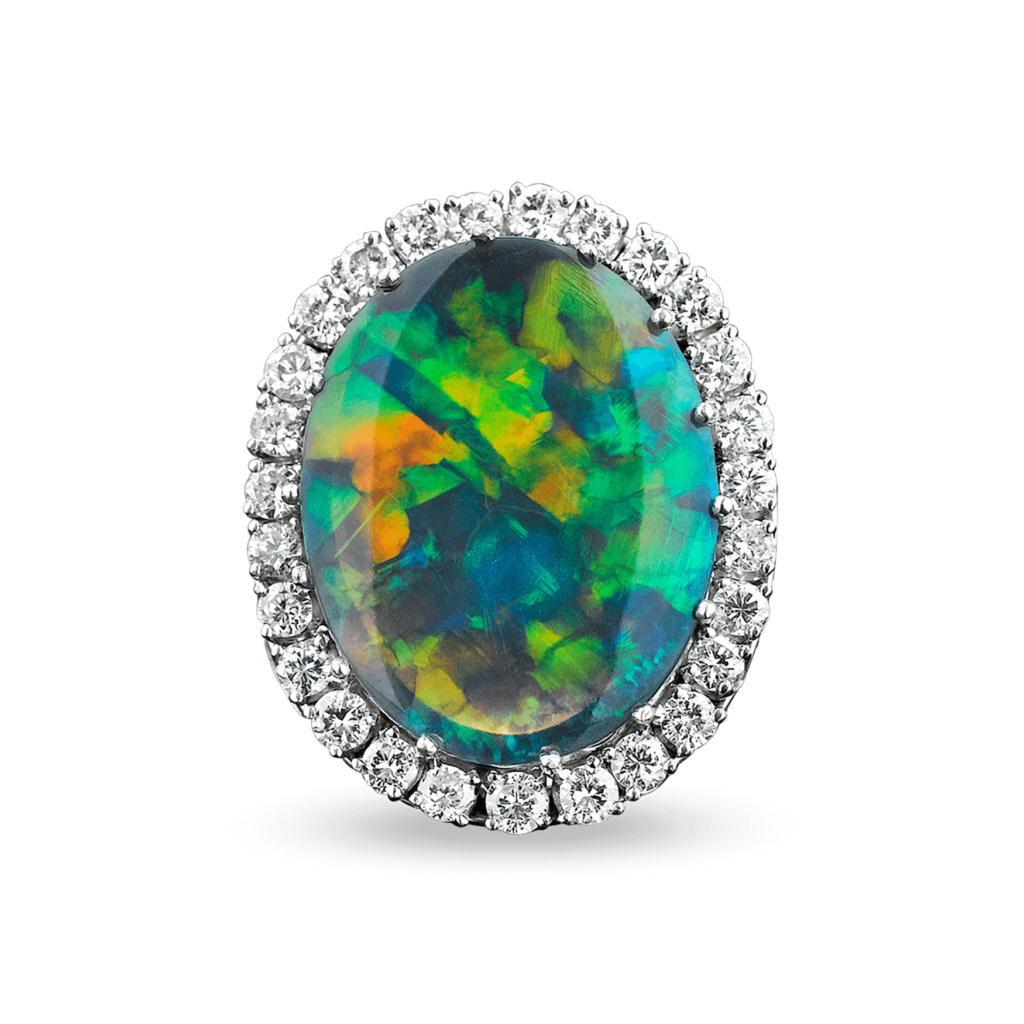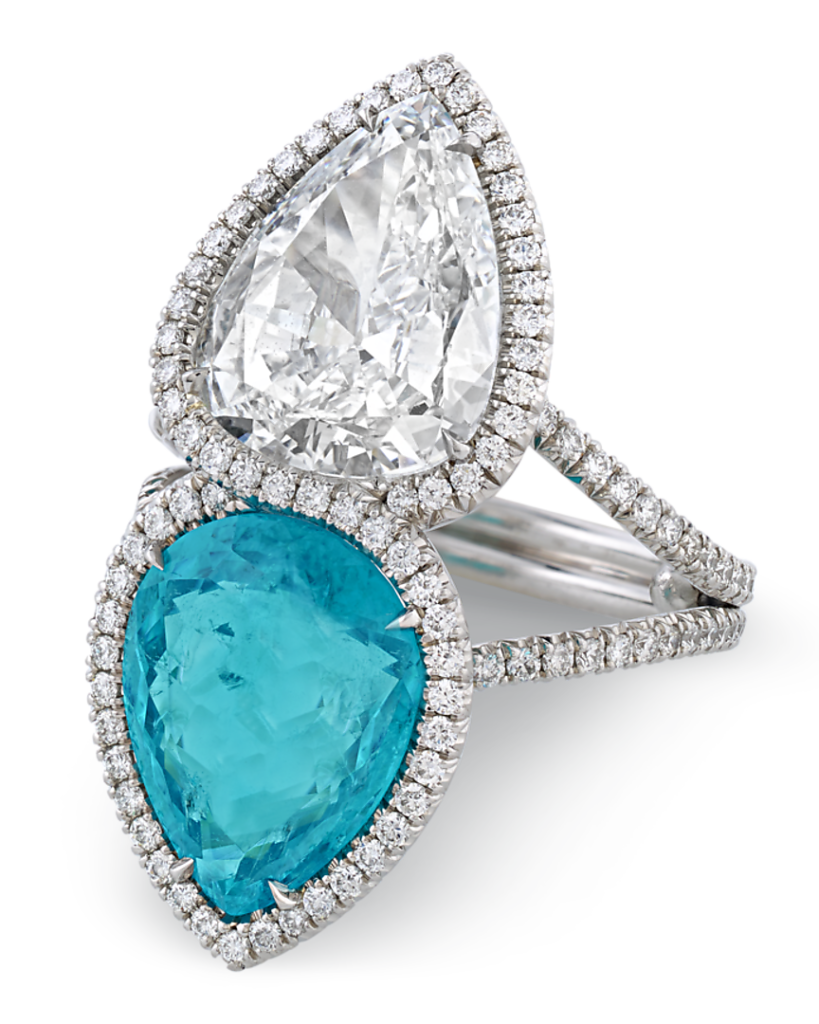Today, we admire them for their elegance and the artistry they inspire, but gemstones have been venerated worldwide for thousands of years. Their beauty and rarity made them particularly prized even then as personal, but for our ancestors, the idea of such stunning substances coming from the earth was nothing short of magical.
Over the millennia and within numerous cultural traditions, each gemstone became correlated with various mystical attributes, with some even believed to have the power to heal the sick. With histories that blend a bit of fact with fantastical legend, let's explore some of the mystical properties of gemstones we know and love.
Diamond

A pear-cut white natural diamond that is graded as a D color, meaning the diamond is colorless without any presence of other trace elements.
When discussing diamond properties, it’s impossible not to mention that this stone is the hardest naturally-occurring substance on earth, which is a fact that wasn't lost on our ancestors. In fact, the word "diamond" comes from the Greek word "adámas" which means "unbreakable". The earliest evidence of diamonds dates to India in the 4th century B.C., where the crystal jewel was already prized as much for its strength as its beauty. Because of their healing properties and their impressive quality, gem diamonds have been highly prized around the world.
This strength led the natural diamond to be associated with protection, and the crystal was believed to ward off evil spirits, increase physical strength, cure the sick, and safeguard the wearer on the battlefield. It has even been believed to be a "master healer" with numerous legends that tell of diamonds being crushed to form elixirs that were thought to cure almost any illness imaginable.

Pope Paul VI's ring, centered by a stunning 13.5-carat Old European cut diamond.
Though it may not heal the sick, the diamond's association with strength still holds true today. The protective stone remains the jewel of choice for engagement and wedding rings, representing the power of true love, loyalty, and devotion.
Ruby

A dramatic oval ruby displays a brilliant crimson hue in this classic ring
A gemstone long associated with beauty and wisdom, rubies are the red variety of chromium, with blue being known as sapphire. Closely associated with the element of fire, the ruby has been associated with the most intense emotions of passion and fury.
In India, particularly Burma (present-day Myanmar) where the most prized "pigeon blood" rubies have been mined since 600 A.D., exists some of the most intriguing lore. Warriors believed it to be an excellent stone of invincibility. But it wasn't enough to actually wear the stone in combat, but the soldier was expected to "become one" with the ruby and actually embed the stone into the skin.

Untreated Ruby and Diamond Ring, 3.02 Carats
Warriors were not the only class that prized the ruby. The gemstone has been an object of desire for royalty for centuries. In 1367, England’s “Black Prince” was given a ruby by the Prince of Granada. Every king from Henry V through Richard III work the jewel in battle. In King Henry V’s case, he wore the ruby in his helmet and credited the jewel for saving his life by deflecting a blow during the battle of Agincourt in 1415. Today, the jewel can be found in the Imperial State Crown of England. Coincidence? You be the judge.
Sapphire

This stunning, natural Burma sapphire boasts 35.07 remarkable carats
Ancient peoples have long associated the sapphire with the heavens. Clergy during the Middle Ages wore sapphires to symbolize Heaven and blessings. Mystics in India believed the jewel could open a passage to heavenly realms. Many near east traditions believed that the earth itself was a sapphire and crediting the color of the sky to the reflection of the sun into the hemisphere.
This association with the heavens also led to the sapphires perceived power over dreams and attributes of the mind. Sleeping with a sapphire by one’s head was said to turn dreams into reality or get rid of unwanted thoughts. For those who communed with spirits, such as the famed ancient Greek oracles at Delphi, the gem would be worn to receive the clearest, most accurate visions.
Untreated Emerald

A 13.63-carat Colombian emerald ring
Philosopher Pliny the Elder spoke admirably of the emerald lamenting "...nothing greens greener". "Emerald" is derived from the Greek word "smaragdus" meaning "green", and it is for this trait that the gemstone has forever been linked to the earth and nature in general. Just as being outdoors is known to ease tension and induce a since of calm, it was also held that simply gazing at the green healing gemstone could soothe the soul.l.
Perhaps the best-known lover of the emerald was Egypt’s Queen Cleopatra. The emerald was first mined in the North African country sometime around 330 B.C. She and her people held strong beliefs in the power of the verdant jewel. She is said to have gifted visiting dignitaries with large emeralds carved with her likeness, as the gem was associated with youth and fertility. The emerald was also believed to treat ailments of the eye, with its calming properties thought to cure a host of visual disorders.
Opal

Black Opal and Diamond Ring, 9.10 Carats
Few gemstones conjure thoughts of the mystical like the opal. With the finest examples displaying a brilliant play of color that has been compared to the glory of the universe and the light of Heaven, it has been a stone most strongly associated with spiritualism and imagination. Once viewed as the cursed opal, this gemstone has had many different properties and meanings throughout history.
Ancient peoples were convinced that for those who possessed supernatural abilities, the opal would help amplify those gifts. Black opals, in particular, were thought to assist in reaching a higher spiritual existence and by erasing inhibitions and negative emotions. Black opals were also used by our ancestors in palliative care, believing the healing gemstone had the ability to replace physical pain with feelings of inner peace and love. As a gem that supports mental clarity and emotional healing, opals are highly admired by many collectors.

This graduated opal bead necklace features 31 opal beads weighing 493 total carats. Measuring just over 35" length, this opera-length necklace exudes luxury.
The opal received a negative connotation in the 1800s when Sir Walter Scott alluded to the jewel in his book Anne of Geierstein, associating the opal with bad luck. However, this has no basis in cultural beliefs of any known civilization. In fact, the opal has historically been connected with good luck and prosperity.
Aquamarine

Aquamarine and Diamond Ring, 23.30 Carats
A turquoise gemstone whose outstanding ocean-blue hue has forever connected it to the sea, the aquamarine gemstone has a long history of admiration by those close to the sea. Its name is taken from the Latin "aqua" for water and "marina" for the sea. The Greek god of the sea, Poseidon, was said to have been represented by the stone. Sailors would carry an aquamarine with them for protection, and those left behind waiting for their loved ones to return are said to have thrown aquamarines into the sea in hopes to see their relative's safe return.
Akin to the natural properties of water, some cultures held that wearing a turquoise aquamarine promoted emotional flexibility, intellectual reasoning, and gentle demeanor, which made it the stone of choice for those who were faced with life's difficulties or other challenges. It is for this reason that aquamarine is considered the optimal precious stone of inner peace.
Tourmaline
 Tourmaline is one of the few precious gemstones that comes in nearly every color imaginable. For that reason, the healing stone has been affiliated with creativity and goodness. The peoples of ancient India credited tourmaline with being able to foster feelings of optimism and could even help the wearer figure out the root cause of their troubles. It was also thought to assist in communication and reconciliation, attracting healing and comradery. Due to its healing properties, this precious stone has been highly sought-after for centuries.
Tourmaline is one of the few precious gemstones that comes in nearly every color imaginable. For that reason, the healing stone has been affiliated with creativity and goodness. The peoples of ancient India credited tourmaline with being able to foster feelings of optimism and could even help the wearer figure out the root cause of their troubles. It was also thought to assist in communication and reconciliation, attracting healing and comradery. Due to its healing properties, this precious stone has been highly sought-after for centuries.
Garnet

A Victorian Garnet Jewelry Suite, circa 1830
The final jewel in our examination of mystical gemstones is the garnet. It has often been referred to as a “karma stone”. If given as a gift, it will bestow affection and prosperity to both the giver and receiver. If it is stolen, it will bring terrible misfortunes upon the thief until it is returned to the owner.
Warriors also associated the garnet with protection, and if an injury did occur, the jewel was thought to stop the flow of blood and assist in healing if inserted into the wound. The Egyptians believed the garnet to be so vital, that pharaohs were commonly buried with multitudes of garnet-laden accessories and loose stones to accompany them into the afterlife, for it was said that even the dead held them to be priceless.
Delving into these ancient tales adds an even greater air of intrigue to the already fascinating history of these precious gemstones. Although they may not grant supernatural powers, there’s no denying the joy they bring to those who wear them.
Looking to find a gemstone engagement ring or stunning antique piece of jewelry? If so, shop our wide selection of excellent stone jewelry today.






